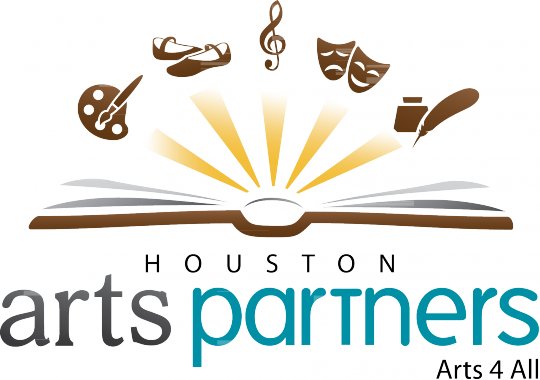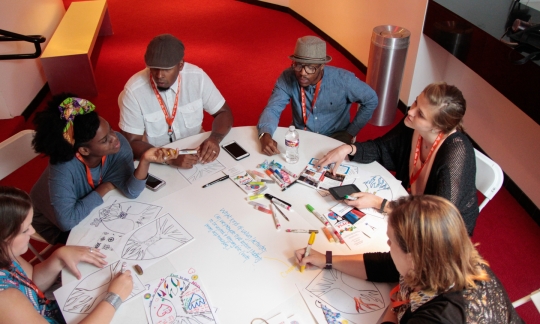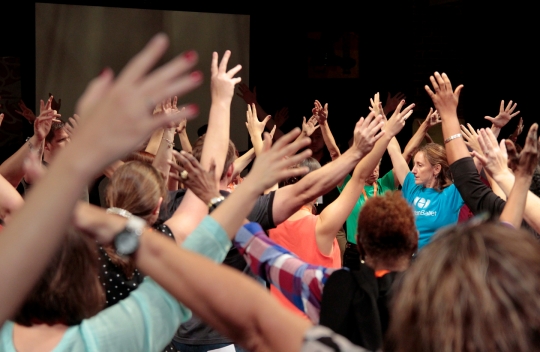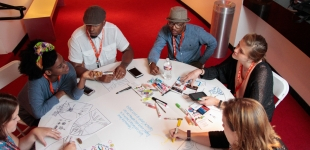
Contributed by Faith Webber, Director of Communications and Community Engagement at Young Audiences of Houston
On September 9 and 10, 2016, a thousand educators, campus and district leaders, and teaching artists from across Texas gathered at the Alley Theatre and Jones Hall in downtown Houston for the 6th annual Houston Arts Partners Conference.
The Houston Arts Partners coalition, comprising over 80 Houston arts organizations and school districts that contribute every year, was first formed by Young Audiences of Houston and several school districts in response to budget cuts which drastically affected arts education access. Originally implemented to facilitate the expansion of arts access for students and demonstrate the powerful effects of arts-infused learning for students and teachers, the HAP coalition and the annual conference continue to be crucial arenas to further this conversation.
Since inception in 2011, the conference has been presented in partnership with media sponsor Houston Public Media. The 2016 event co-chairs, who were elected by the HAP coalition members to provide representative leadership from arts organizations and school districts, were Pam Blaine of the Houston Symphony, Joe Clark of Spring ISD, and Mary Sutton of the Alley Theatre. Over 25 other arts organizations and districts contributed planning and presentations.
 Caroline Edmundson of the Texan-French Alliance for the Arts facilitates an art-making activity developed in partnership with FotoFest. Photo by Katy Anderson
Caroline Edmundson of the Texan-French Alliance for the Arts facilitates an art-making activity developed in partnership with FotoFest. Photo by Katy AndersonThis year, three verbs framed the focuses of the conference. “With the theme ‘Motivate – Engage – Transform: Re-Designing the Future of Education,’ we are addressing the most fundamental skills conferred by arts participation,” explained Houston Arts Partners conference coordinator Troy Scheid, a Young Audiences of Houston staff member who has managed the conference since 2013. “By involving educators at all levels – from classroom teachers to campus leaders and district executives—we are finding areas of growth for the arts and arts integration that will carry the effects of the conference beyond the conference itself and truly re-design education in our region.”
To kick off the conference early Friday morning, four young students of the Alley Theatre performed original slam poetry adaptations of a scene in A Midsummer Night’s Dream, priming attendees for two days of intensive exploration. In his opening address, keynote speaker and arts integration champion Eric Booth hailed this performance as a great example of engaged learning. “Arts integration is interesting because, once it’s successful, it always turns into something else,” Booth pointed out. “No eighth-grader writes slam poetry about Shakespearean characters to score better on a test, but I bet those kids outscore their peers in statewide exams.”

Jennifer Sommers leads conference participants in Houston Ballet's session on movement and critical thinking. Photo by Katy Anderson
This was just the first of many innovative partnerships showcased at the conference. The vital content of the HAP conference is the compact, intensive sessions— led by many Houston arts organizations and their school partners—that emphasize evidence of impactful, hands-on experiences in arts integration. Encompassing theatre, dance, creative writing, music, and the visual arts, these participatory sessions showcased the endless possibilities for collaboration among Houston’s most driven educators and artists.
With almost 50 individual sessions, attendees could choose from a vast spectrum of opportunities. On Friday, some teachers took advantage of a lesson by the Houston Ballet strengthening critical thinking through movement or a program with Writers in the Schools developing creative writing through video game design. On Saturday, Theater Under The Stars explored social-emotional learning through story and drama while the Apollo Chamber Players recapped a successful school residency focusing on music, history, and personal identity.
Attendees also heard from two other featured speakers who underscored the conference theme. Friday morning, Dr. Adele Diamond, an expert on the brain’s prefrontal cortex, spoke on the development of executive functions in response to arts-integrated classrooms. She demonstrated that activities utilizing passion and personal identity improve cognitive skill-building in young learners. “Joy is not the opposite of serious,” Dr. Diamond finished, “and serious business, like learning, can be joyful. When these overlap, there is no distinction between work and play.”
On Saturday, the second highlighted speaker, policy expert Jeff M. Poulin, spoke on behalf of Americans for the Arts. He outlined the specifications of the new Every Student Succeeds Act (ESSA) and moments of opportunity for fine arts and arts-integrated education to receive support. He advised conference attendees to use this shift in policy as a tool for transforming education through increased advocacy efforts.
By Saturday afternoon, HAP Conference attendees were exhausted and enthralled. Eric Booth returned to the mic one last time to, as he put it, “preach to the choir.” Through a handful of exercises, he urged participants to keep the momentum of inspiration and potential collaboration rolling through to their classroom practice.
He empowered participants to create “lifelong yearners”, students who seek to grow through all disciplines with passion and vigor. “Arts integration,” Booth concluded, “is the way to fulfill the birthright of every kid in our area so they have the habit of mind of lifelong yearning; making things they care about and having the innate courage and belief of the value of those things so that they want to share them with others.”


